Abstract
Tramadol (TD) has been prescribed frequently in many countries for more than 40 years, but there is a risk of its misuse and trafficking. As a result, drug analysis has numerous legal and socially relevant implications, making it an essential part of modern analytical chemistry. Thus, the method for the detection of TD and its phase I and phase II metabolites in human urine has been developed and validated using a rapid and efficient approach combining liquid chromatography-tandem mass spectrometry (LC-MS/MS) with electrospray ionization. The sample preparation was best performed using dispersive liquid–liquid microextraction. Analysis was performed using an HyPRITY Cl8 column, and isocratic elution with methanol: water (35:65) with 0.2% formic acid was used. TD and its metabolites were detected at 264.2 (TD/M0) with a base peak at 58.2, 250.3758 (M1), 250.3124 (M2), 236.3976 (M3), 222.5361 (M4), and 236.4475 (M5) m/z peaks. TD showed linearity between 0.1 and 160 ng/mL (R2 = 0.9981). The accuracy ranged from 95.56 to 100.21% for the three concentration levels, while the between- and within-day RSD ranged from 1.58 to 3.92%. The absolute TD recovery was 96.29, 96.91, and 94.31% for the concentrations of 5, 50, and 150 ng/mL, respectively. TD’s phase I metabolites, M1–5 along with nine phase II metabolites, such as sulfo- and glucurono-conjugated metabolites, oxidative TD derivatives, and sulfo-conjugated metabolites were also identified in the urine samples. The pharmacokinetics and metabolism data given provide information for the design of possible future research disorders, evaluating drug mechanism and neurotoxicity and for the effective application screening of TD.
1. Introduction
TD is a 2-(dimethylaminomethyl)-1-(3-methoxyphenyl) cyclohexanol or 4-phenyl-piperidine analogue of codeine. TD, a widely prescribed analgesic, has gained significant attention in the field of pain management due to its efficacy in alleviating moderate to severe pain [1]. TD may provide a euphoric effect comparable to oxycodone when taken orally in large dosages. The predominant causes of Tramadol poisoning have been identified as suicide attempts (52–80%), followed by abuse (18–31%), and accidental intoxication (1–11%). At least 20% of instances of TD poisoning were associated with a history of chronic TD misuse or opioid dependency [2]. As a prodrug, TD undergoes extensive metabolism in the liver. Understanding the metabolic profile of TD is crucial for evaluating its pharmacokinetics, therapeutic monitoring, drug interactions, and forensic analysis [3]. It is frequently taken orally and is quickly absorbed completely, with distribution in two hours. TD has a therapeutic blood concentration range of 0.1 to 0.3 mg/L. Moreover, blood values of 1 and 2 mg/L have been described as potentially dangerous and fatal, respectively [4,5].
TD has around 20% plasma protein-binding and a therapeutic plasma concentration. When taken orally, TD is rapidly absorbed and has a 65–70% bioavailability. The elimination of TD from the human body primarily occurs via renal excretion after hepatic metabolism through N- and O-demethylation processes, facilitated via cytochrome P450 pathways, particularly CYP2D6. As a result, overdose or intoxication might result from a deficiency in these systems or the concurrent use of other drugs processed via the same hepatic pathways. TD’s analgesic effectiveness is primarily due to ODT (O-desmethyl TD), a pharmacologically active metabolite. Around 10–30% of the parent dosage in the urine is excreted unaltered [6,7]. TD and M1 (ODT) have half-lives of 5–6 and 7–9 h, respectively. Thus, regular dosage may cause bioaccumulation due to M1’s extended elimination half-life [8]. The six metabolic pathways that inculcate N-demethylation, O-demethylation, oxidative N-dealkylation, dehydration, cyclohexyl oxidation, and conjugation yield TD metabolites [9]. The primary metabolites are M5 (N,O-desmethyl TD) and its conjugates, M1 and its conjugates, and M2 (N-desmethyl TD), whereas M3 (N,N-desmethyl TD) and M4 (N,N,O-desmethyl TD) and their conjugates are only formed in minimum concentrations. Phase I reactions yield 11 metabolites, whereas phase II reactions generate 12, and the most active metabolite is M1 (Figure 1) [10].
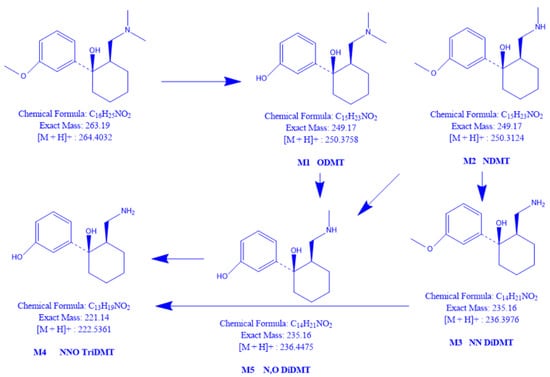
Figure 1.
Illustrates the metabolic pathway of TD.
Drugs only persist in various matrices for a brief period of time. Drugs can be detected in both saliva and blood for a period of time of 24 h. Drugs can be traced in urine for up to 40 h and in hair samples for up to 90 days. When comparing urine to other biological samples, such as blood or plasma, TD and its metabolites generally occur in higher concentrations in urine. The identification and accurate quantification of these substances may be made possible by the increased concentration. Additionally, compared to other matrices that might have enzymatic activity or undergo fast metabolism, urine samples are very stable. Compared to other sample collection techniques, including blood or tissue sampling, collecting urine is a non-invasive and very simple procedure. Large quantities of it are easily obtainable, facilitating repeated or longitudinal testing [11].
TD is a controlled substance in many jurisdictions, and its abuse potential has led to its inclusion in drug testing panels. Testing for TD metabolites can help identify TD use and differentiate it from other opioids or drugs of abuse, aiding in forensic investigations and workplace drug testing programs. Thus, the analysis of TD metabolites is important for understanding the drug’s pharmacokinetics, monitoring therapeutic response, assessing drug interactions, investigating overdoses, and conducting forensic analyses.
For TD and its metabolites analysis, numerous HPLC methodologies using fluorescence [12], ultraviolet [13], MS detection [14], and electrochemical [15,16] have been developed. Chiral high-performance liquid chromatography (HPLC) detection methods help to analyze TD and its metabolite enantiomeric ratios [17,18]. As per the previously reported studies, the chiral column was used to identify and separate TD, M1, and M2 metabolites in the plasma and urine samples [19,20,21,22]. TD misuse or overdose can lead to severe adverse effects, including respiratory depression, seizures, and even death. The identification of phase I and phase II metabolites is vital in toxicology investigations to determine the extent of TD exposure and assess the contribution of specific metabolites to toxicity. By identifying and quantifying these metabolites in biological samples, such as urine or blood, toxicologists can gain insights into the metabolic pathways involved in TD toxicity and facilitate appropriate medical interventions. Chiral columns have their advantages for the enantiomeric separation of TD, they also present disadvantages such as limited applicability, increased method complexity, higher cost, reduced column lifetime, and lack of universality. However, achiral analytical techniques have also emerged in pharmacokinetic and bioequivalence assessments and forensic investigations. In contrast, achiral columns offer advantages such as broader applicability, simpler method development, and cost-effectiveness. They can be used for the separation of a wide range of compounds, including TD and its metabolites, without the need for enantiomeric resolution. Achiral columns are generally more robust, exhibit longer column lifetimes, and provide greater flexibility in method development and optimization. There is no such significant achiral approach in human urine for the identification and separation of TD and its metabolites (M1, M2, M3, M4, and M5) [23,24,25].
In the present study, we aimed to develop and validate a robust LC-MS/MS method for the simultaneous determination of TD and its phase I and II metabolites in human urine. The developed method offers several advantages over conventional analytical techniques, including enhanced sensitivity, specificity, and efficiency in detecting and quantifying multiple analytes within a single analytical run. In particular, the determination of TD and its phase I and II metabolites in human urine is of great importance due to their clinical significance and potential abuse. However, the analytical determinations of these compounds have broad applications, extending beyond drug manufacturing to include forensic science and the quantification of banned substances in cases related to doping or drug abuse. The separation of TD and metabolites via chromatography was acceptable, resulting in a quick turnaround for the analysis. The study successfully investigated the parent and metabolites of a 50 mg TD dosage in urine.
2. Materials and Methods
2.1. Chemicals and Reagents
Acetonitrile, methanol, formic acid, chloroform, diethyl ether, and ethyl acetate of HPLC grade were procured from Merck, India. The reference standards of TD hydrochloride were procured from the Indian Pharmacopoeia Commission, India. The formulations of (Tramazac) TD hydrochloride was procured from Janssen Pharmaceuticals and Zydus Cadilla, India.
2.2. Urine Sampling
Four volunteers were considered since these individuals were already on TD. The volunteers were from the age group of 25–30 and they were prescribed TD by their doctors. The individuals were briefed about the study’s objective and consented to participate. The volunteers were prohibited from taking any other drug for the preceding 24 h. The participants fasted for 12 h before ingesting 50 mg TD (a 50 mg Tramazac capsule) with water and then fasted for another 2 h. After collecting the last urine samples, the individuals were monitored for up to 24 h.
2.3. Sample Collection
Before the intake of TD at 2, 4, 6, 8, 10, and 12 h after the dose, urine samples were collected. For analysis, 10 mL of the urine was collected, centrifuged, decanted, and kept at −4 °C.
2.4. Preparation of Standard and Quality Control Samples
Accurately weighed standard was dissolved in CH3OH, and a stock solution of 1 mg/mL TD standard was prepared. The working solution was made by diluting the solution with CH3OH and then putting it in the fridge at −4 °C. TD concentrations in the range of 0.1 to 160.00 ng/mL were used to create the calibration curves. The quality control (QC) samples were made from blank urine and spiked with three concentrations of individually prepared stock standard solutions.
2.5. Sample Preparation and Extraction Procedure
Various combinations of liquid–liquid extraction (LLE) and dispersive liquid–liquid microextraction (DLLME) were used to improve the extraction’s effectiveness. The DLLME approach was found to be superior to LLE in this study. Various solvents (ethyl acetate, diethyl ether, CH2Cl2, CH3CN, C4H9OH, and CHCl3) were examined for DLLME. Lastly, 0.5 mL of pre-treated urine was injected with a dispersive and binary extraction solvent combination (ethyl acetate and chloroform (1:2)). A turbid solution was created immediately. The dispersed tiny droplets of chloroform and ethyl acetate were collected after the cloudy solution was centrifuged for ten minutes at 4500 rpm. After being dried, the phase that had been deposited was moved to another glass tube.
2.6. Analytical Conditions
2.6.1. Instrumental Conditions
A Thermo Scientific, India, Accela HPLC System with an Accela Pump 1250 and an Accela Autosampler Plus SRVYR-ASP interfaced to a Thermo Scientific TSQ Quantum Access MAX with an ESI interface was used for the LC-MS/MS analysis. LCQUANTM quantitation software 2.6.0.1128 and TSQTM tune master software 2.3.0.1206 version SP1, India were used to acquire chromatograms and mass spectra, respectively.
2.6.2. Chromatographic Conditions
Mobile phase equipment and an analytical Thermo Fisher Scientific HyPURITY RP C18 (150 × 4.6 mm ID, 5 µm) column were utilized for chromatographic separation. The mobile phase of CH3OH:H2O (35:65 v/v) with 0.2% HCOOH has been used. The analyte was eluted at a flow rate of 500 µL/min. The run was scheduled to last ten minutes. For optimal sensitivity, the auxiliary gas pressure of 20 V, the spray voltage of 4525 V, the temperature of the vaporizer of 350 °C, the sheath gas pressure of 55 psi, and the capillary temperature of 350 °C was chosen. Data were collected for mass spectrometry between 2.5 and 10.0 min. Post-column splitting was used to divert column eluent for disposal of the remaining time.
2.6.3. Pharmacokinetic Analysis of TD in Human Urine
Before the medicine was administered (pre-injection: time 0) at 2, 4, 6, 8, 10, 12, and 24 h after a single 50 mg dosage, urine samples were collected and stored at −4 °C. Urine samples were extracted following the aforementioned method. Each sample was introduced into the LC/MS/MS apparatus in an aliquot volume of 5 µL.
2.7. Method Validation
A total of five urine samples, both with and without an internal standard to account for interference peaks. The amount of TD or IS (TD-d6 50 ng/mL) that could be extracted from urine was estimated by adding TD or IS in triplicate to a sample of blank urine. These sample’s total peak areas were compared to a reference sample at each concentration. The reference sample was extracted from blank urine, mixed with the drugs, and processed as previously mentioned in triplicate for each concentration. After injecting multiple TD standard solutions into urine blanks and processing the samples, calibration curves for eleven urine concentration levels were produced. TD concentrations (x) spiked in blank urine were compared to the drug’s peak area ratio (y).
The spectrum of QC sample concentrations was examined in sextuplets to establish intra-day accuracy and precision. The sextuplets’ peak area ratios were used to measure precision. Each sample’s concentration and percentage deviation was determined from the previous calibration curve. The precision and accuracy of QC samples were determined thrice. The percentage change between each QC’s nominal and mean concentrations was used to estimate the accuracy for up to three days. The detection limit was set as the lowest concentration of TD that could be found with a signal-to-noise ratio of three-to-one. The limit of quantitation was determined based on the calibration curve’s lowest concentration. Three LOQ samples were examined in triplicate for three days. Three distinct concentrations of standard quality control samples were frozen at 4 °C from a fresh stock solution of drug-free urine analytes.
3. Results and Discussion
3.1. Discussion on TD
TD and its metabolites can be simultaneously identified and separated, allowing for a comprehensive analysis of the parent drug and all of its different metabolites in a single analytical run. Various phase I and II metabolites are produced as a result of TD’s broad metabolism in the body. TD’s pharmacokinetics, metabolism, and forensic/toxicological applications have all benefited from the development of an approach for the simultaneous identification and separation of TD and its phase I and II metabolites from the biological matrices. Thus, the methodology was developed to identify and separate the maximum number of TD metabolites from the single dosage of TD from urine samples because the majority of the previously developed methodologies were focused on the identification of TD, ODT, and NDT.
3.2. Method Validation
3.2.1. Optimization of LC Conditions
One of the essential factors in the chromatographic analysis is the mobile phase. The mobile phase’s constituents can significantly affect the method’s sensitivity, retention time, and analyte separation. The current study intended to establish a method for the simultaneous detection of TD and its metabolites, employing DLLME extraction as a sample preparation methodology, with the targeted molecule separated using an achiral C18 column. MS–MS detection was then utilized. HyPURITY Cl8 (150 × 4.6 mm ID 5 µm) analytical achiral column was employed with a mobile phase apparatus to separate chromatographically.
Formic acid at various concentrations and different ratios of organic solvents (methanol/acetonitrile) were studied. Columns were also examined for the best sensitivity, resolution, and retention time. Several mobile phases were tried in order to separate all the targeted analytes. The optimum separation conditions for TD and its phase I and II metabolites involve utilizing 0.2% formic acid along with a mixture of CH3OH and H2O in a ratio of 35:65 (Figure 2). An operation rate of 500 µL/min for analyte elution was utilized, and ten minutes were allocated for the runtime.
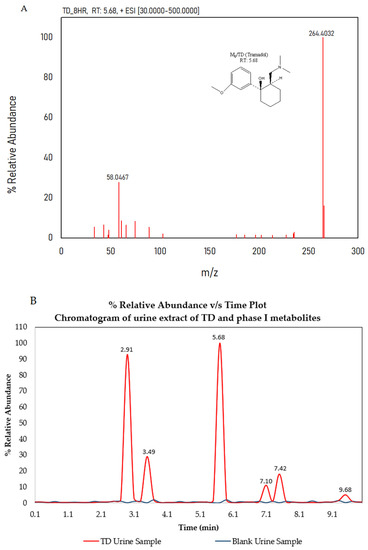
Figure 2.
(A) Mass spectrum and (B) the TIC chromatogram of the urine extract (collected from a volunteer) of a TD and phase I metabolites (orange) and blank urine extract (blue) using CH3OH:H2O (35:65) with 0.2% HCOOH as the mobile phase at a flow rate of 0.5 mL/min using a HyPURITY Cl8 column.
3.2.2. Optimization of Mass Conditions
During MS/MS optimization, the compound was initially directly introduced into the MS detector through ESI ionization to achieve optimal MS conditions. Spray voltage, auxiliary gas pressure, vaporizer temperature, sheath gas pressure, and capillary temperature were all optimised to yield protonated pseudo-molecular ions of TD and metabolites. Examining the peak response of fragment ions to determine the appropriate collision energy. When the collision energy was 10 eV, the mass spectra of product ions (Figure 2, Figure 3, Figure 4, Figure 5, Figure 6 and Figure 7) revealed that TD had a dominant fragment ion peak at m/z 58. We optimized the MS/MS parameters and reported findings.
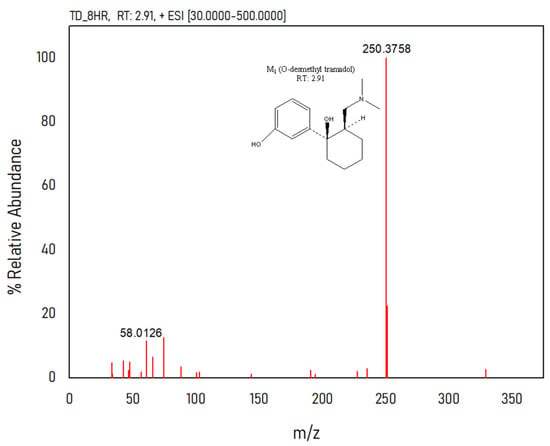
Figure 3.
Mass spectrum of urine extract at RT: 2.91, m/z 250.3758 corresponding to the [M + H]+ ion of O-desmethyl TD (M1/ODMT).
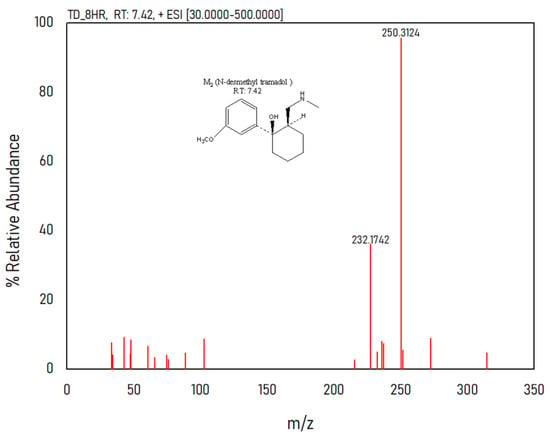
Figure 4.
Mass spectrum of urine extract at RT: 7.42, m/z 250.3124 corresponding to the [M + H]+ ion of N-desmethyl TD (M2/NDMT).
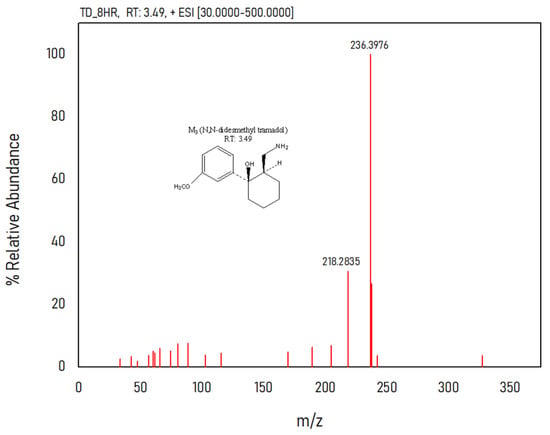
Figure 5.
Mass spectrum of urine extract at RT: 3.49, m/z 236.3976 corresponding to the [M + H]+ ion of N, N-desmethyl TD (M3/NDT).
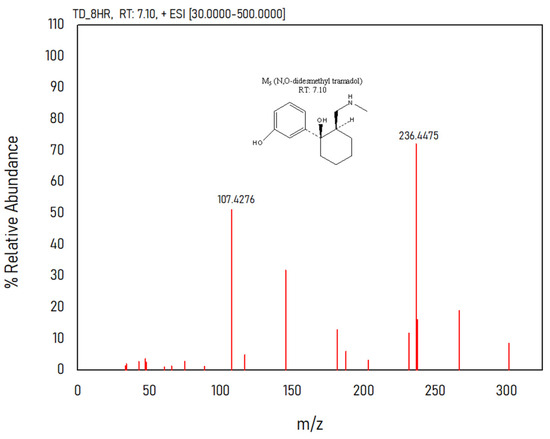
Figure 6.
Mass spectrum of urine extract at RT: 7.10, m/z 236.4475 corresponding to the [M + H]+ ion of N, N-desmethyl TD (M5).
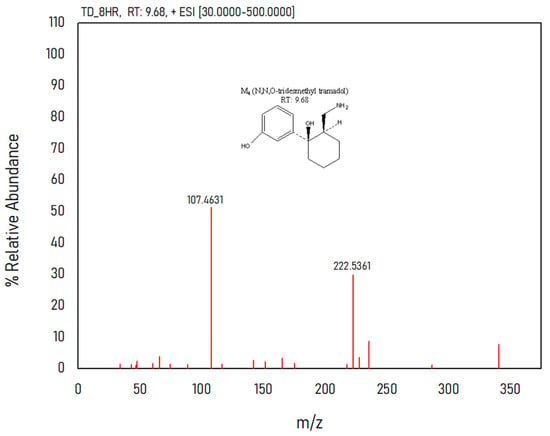
Figure 7.
Mass spectrum of urine extract at RT: 9.68, m/z 222.5361 corresponding to the [M + H]+ ion of N,N,O-tridesmethyl TD (M4).
3.2.3. Optimization of the Extraction Procedure
Before the LC-MS analysis of complex biological matrices, sample clean-up, whether via liquid–liquid extraction (LLE), dispersive liquid–liquid microextraction (DLLME), or solid phase extraction (SPE), is still suggested. Most techniques published for TD in biofluid determination used LLE to clean up biological samples. As per the previous studies, the DLLME and LLE are the most frequently used extraction procedures for extracting drugs from the urine matrix [26].
Both methods have been performed to accelerate extraction efficiency, as depicted in Figure 8. Thus, various combinations of dispersion and extraction solvents have been used, including chloroform (C), methanol (M), diethyl ether (DE), ethyl acetate (EA), etc. To conduct sample separation using DLLME, specific prerequisites must be achieved. The dispersing solvent must be completely soluble in water. Acetonitrile, acetone, and methanol are commonly utilized for this purpose. The solvent must be extracted to achieve a few characteristics, and it must be able to extract analytes. Additionally, it must be soluble in the dispersion solvent and sparingly soluble in water. Selecting the extracting and dispersing solvents carefully is necessary to achieve a significant enrichment factor. TD and its metabolites were extracted from human urine using a variety of procedures. Multiple organic solvents, such as diethyl ether, dichloromethane, tert-butyl methyl ether, and ethyl acetate, were used to achieve efficient extraction with the DLLME method. Extraction solvent (ethyl acetate and chloroform in the ratio of 1:3) and dispersion agent (methanol) were combined to create the best extraction method at a ratio of 1:2 for 10 min, and the extraction tubes were centrifuged at 4500 rpm. Using this procedure, the efficient extraction of TD along with the maximum number of metabolites was achieved.
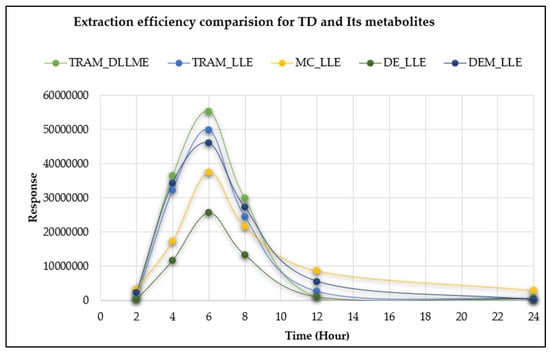
Figure 8.
Represents the extraction efficiency of TD comparison for better recovery rate in the urine sample, which illustrates that DLLME has better extraction efficiency over LLE.
In the previously reported extraction procedures, DLLME, LLE, and SPE were used to extract TD with great efficiency but not the metabolites of TD. The DLLME approach for determining TD in urine samples was compared to previously described methods. The suggested approach has a lower LOQ, a better linear range, higher relative recoveries, and a broader range of analytes identified than earlier studies, including phase I and phase II metabolites. Additionally, DLLME’s extraction process takes less time overall, and there are no labor-intensive or prolonged steps in this process.
3.2.4. Method Validation
Selectivity and specificity are the ability of an analytical method to differentiate and quantify the analyte in the presence of other components in plasma samples. The separation of TD and its metabolites through the utilization of the experimental parameters is described in Table 1.

Table 1.
Represents the identified and separated phase 1 metabolite of TD found in the urine sample.
The selectivity of the methodology was demonstrated by the absence of an endogenous MS response and/or peak at analyte retention times. The chromatograms of reference urine and urine-spiked samples with drugs demonstrated no endogenous interference during the retention time of the peak of interest, which validated selectivity. TD (M0), M1, M2, M3, M4, and M5 retention times were 5.68, 2.91, 7.42, 3.49, 9.68, and 7.1 min, respectively, represented in Figure 2, Figure 3, Figure 4, Figure 5, Figure 6 and Figure 7.
Using a weighted least squares approach, it was observed that the calibration curves for the urine test created with a peak area ratio (y) of TD versus drug concentration were linear across the concentration range of 0.1–160 ng/mL. The linear regression equations of the calibration curves are summarized in Table 2. The standard curve correlation coefficient was 0.9981 (Figure 9).

Table 2.
Illustrates the linearity of TD in human urine.
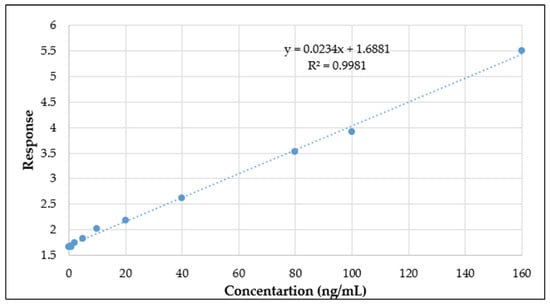
Figure 9.
Represents the calibration curve of TD in human urine linearity over the concentration range.
Table 3 summarizes the findings from the method’s validation on the urine matrix. Urine samples were analyzed at three different concentrations six times daily to determine repeatability. The same urine samples were examined once per day for three days to determine the intermediate precision and accuracy. The approach was precise and accurate, and accuracy at three concentrations ranged from 94.85 to 110.25%, and within- and between-day RSD ranged from 1.15 to 3.11% for TD. The absolute recovery of TD for three different concentrations was 94.65, 93.51, and 96.81% for 5, 50, and 150 ng/mL, respectively.

Table 3.
Shows intra-day and inter-day accuracy, precision, and recovery in human urine samples (n = 4).
This is, to the best of our knowledge, the first investigation of a widely accepted method for the determination of TD and its phase I and phase II metabolites in urine samples. This was accomplished using ESI-LC-MS/MS, and the results demonstrated that TD distribution and presence in the urine samples were rapidly distinguished from other compounds. ESI-LC-MS/MS was used to determine the pharmacokinetic and elimination pattern of TD and its phase I metabolites after oral administration in human urine.
The two primary and three minor phase I metabolites of TD, M1, M2, M3, M4, and M5, as well as the pharmacokinetic profiles, were all studied in the current paper. Human urine samples were also taken from the individuals for the study. The TD pharmacokinetic profiles and metabolism in human urine are shown in Figure 10 and Figure 11. The methodology utilized in this work is to separate and identify phase one metabolites. Similar but generated in variable concentrations are the primary phase I metabolites M1 and M2, M3 and M5, and M4. Nevertheless, prior research showed that M1 produced far too little in horse species, with M2 being the predominant metabolite produced. M1 has been found to be the major metabolite in humans as compared to M2 [27].
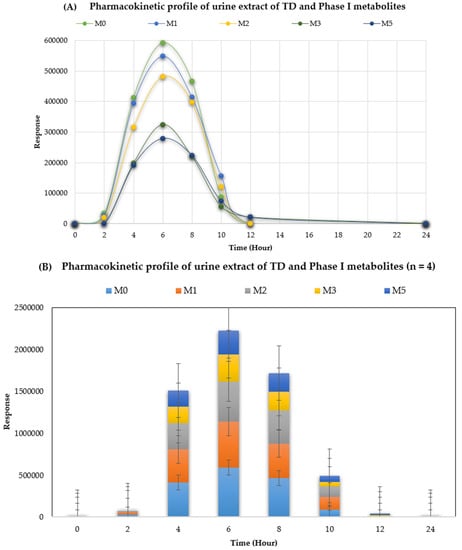
Figure 10.
(A) The pharmacokinetic profile of the urine extracts of TD and phase I metabolites. (B) The average pharmacokinetic profile of the urine extracts of volunteers (n = 4).
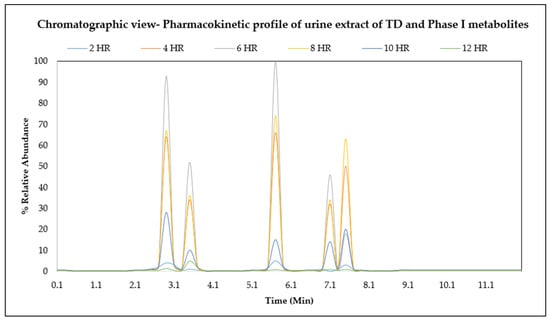
Figure 11.
The TIC chromatographic view of the pharmacokinetic profile of urine extracts of TD and phase I metabolites.
Thus, it is probable that in vivo M1 is responsible for TD’s “opioid-derived analgesic effect,” making it a suitable experimental model for studying the biological impacts of drug misuse and TD’s neurotoxicity. TD and phase I metabolites were detected in human urine samples up to 24 h later using this method’s sensitivity. Figure 11 shows the patient’s cumulative urine excretion curve for TD and phase I metabolites after taking a single Tramazac tablet (50 mg TD HCl). Even though we only studied one participant, our findings are consistent with the literature [28].
The developed method validated TD in the urine sample collected from the four volunteers at various times. Along with the validation of TD in the urine sample, various phase I and phase II metabolites were identified with separation in the run time. The validated method was applied to the pharmacokinetic study of TD after 50 mg TD to five individuals. The sensitivity and specificity of the method were found to be sufficient for accurately characterizing the pharmacokinetics of TD in this study.
Since most of the previously developed approaches were concentrated on the identification of TD, ODT, and NDT, our methodology was developed to identify and separate a wider range of TD metabolites from the single dosage of TD from urine samples (Table 4).

Table 4.
Comparison of the proposed method with other methods for the analysis of tramadol and metabolites.
3.3. Application Method
The method has been validated through TD analysis and its phase I and II metabolites in urine, followed by a single oral dose of 50 mg TD. As a result of liver metabolism, the study found 26 metabolites for TD, including 14 from phase I (M1 to M11 and M31 to M33) and 12 from phase II (namely 7 glucuronides—M12 to 18—and five sulfonates—M19 to 23). However, just 23 of the 26 metabolites that TD produces after oral treatment were found in the urine [25,30,31]. M31 to M33 were discovered solely in liver microsomes at the same time. M12, M19 through M23, and M33 were not found in mice or dogs among these 26 human metabolites. Only the metabolites O-desmethyl TD (M1) and O, N-di-desmethyl TD (M5) are pharmacologically active due to the liver’s metabolism of TD. M1 is cytochrome P450 2D6′s end product of O-demethylation (CYP2D6) [6,32,33].
A total of 14 TD metabolites including five phase 1 (M1-M5) and nine phase II metabolites, three sulfo- and glucurono-conjugated metabolites, three oxidative TD derivatives, and three sulfo-conjugated TD metabolites identified in healthy individuals’ urine samples, were extensively characterized in our study. Additionally, our analysis was the first to use the achiral technology based on ESI-LC-MS/MS to detect 14 TD metabolites, encompassing phase I and II. Figure 12 shows the average excretory profile of TD and phase I and II metabolites in the urine. Table 5 shows the phase II metabolites that were identified (Figures S1–S9).
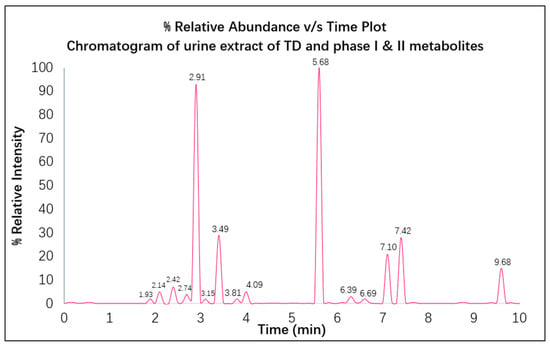
Figure 12.
Represents the TIC chromatographic view of the separation of TD and phase I and phase II metabolites extracted from urine extract.

Table 5.
Illustrates the phase II metabolites detected in the urine sample (n = 4).
4. Conclusions
Globally, the use and abuse of prescription and regulated drugs are rising. Drug overuse may vary from nation to nation but a few substances cross their boundaries via misused technology, the growth of the darknet, and the Internet’s role in connecting the world. One of these drugs is TD, a narcotic recently discovered by enforcement officials to be widely abused worldwide. As a result, analytical approaches are increasingly being used to identify pharmaceutical preparations and toxicological samples, including blood, urine, saliva, and hair. This study uses an achiral column where the methodology based on LC-MSMS with ESI has been developed and validated for detecting TD and its phase I and phase II metabolites in human urine. A precise and succinct DLLME method was used for samples. For four volunteer urine samples, the DLLME method provides strong repeatability and increased recovery in a short period of time. Analyzing TD and its metabolites in the urine matrix is thus practical for forensic and therapeutic drug-monitoring studies. In conclusion, the current work created a straightforward, affordable, reliable, and wide throughput analytical approach for estimating TD and its major metabolites simultaneously in human urine. The pharmacokinetics and metabolism data given in the present study provide information for the design of possible future research disorders evaluating drug mechanism and neurotoxicity and for the effective application screening of TD.
Supplementary Materials
The following supporting information can be downloaded at: https://www.mdpi.com/article/10.3390/separations10060365/s1, Figure S1: MS/MS of urine extract m/z 426.3138 corresponding to [M + H]+ ion of O-desmethyl TD Glucuronide (M13); Figure S2: MS/MS of urine extract m/z 456.4048 corresponding to [M + H]+ ion of OH TD Glucuronide (M16); Figure S3: MS/MS of urine extract m/z 412.1174 corresponding to [M + H]+ ion of N,O-desmethyl TD Glucuronide (M15); Figure S4: MS/MS of urine extract m/z 280.3817 corresponding to [M + H]+ ion of OH TD (M6); Figure S5: MS/MS of urine extract m/z 252.2158 corresponding to [M + H]+ ion of OH-didesmethyl TD (M8); Figure S6: MS/MS of urine extract m/z 266.4093 corresponding to [M + H]+ ion of OH-O-desmethyl TD (M32); Figure S7: MS/MS of urine extract m/z 360.4492 corresponding to [M + H]+ ion of OH-TD Sulphate (M23); Figure S8: MS/MS of urine extract m/z 302.4325 corresponding to [M + H]+ ion of N,N,O-desmethyl TD Sulphate (M21); Figure S9: MS/MS of urine extract m/z 316.4469 corresponding to [M + H]+ ion of N,O-desmethyl TD Sulphate (M22).
Author Contributions
Conceptualization, V.C. and M.S.; methodology, V.C., M.S., A.T., V.T. and M.K.; software, V.C., M.S., A.T., V.T. and M.K.; validation, T.V., G.K. and A.A.; formal analysis, V.C., M.S., A.T., V.T. and M.K.; investigation, V.C., M.S., A.T., V.T. and M.K.; resources, V.C. and M.S.; data curation, V.C. and M.S.; writing—original draft preparation, V.C., M.S., A.T., V.T., M.K., T.V., G.K. and A.A.; writing—review and editing, A.A, N.A., A.S. and O.A.; visualization, V.C., M.S., A.T., V.T. and M.K.; supervision, V.C., M.S., A.T., V.T. and M.K.; project administration, V.C., M.S., A.T., V.T. and M.K.; funding acquisition, N.A., A.S. and O.A. All authors have read and agreed to the published version of the manuscript.
Funding
This research was funded by Princess Nourah bint Abdulrahman University, Researchers’ Supporting Project number (PNURSP2023R141), Princess Nourah bint Abdulrahman University, Riyadh, Saudi Arabia.
Institutional Review Board Statement
The study was conducted according to the guidelines of the Declaration of Helsinki and approved by the ethical committee of National Forensic Sciences University in collaboration with Anand College of Pharmacy in Agra, Uttar Pradesh (series number. IEC/ACP/19, 2 February 2021).
Informed Consent Statement
Informed consent was provided by the participants for the study.
Data Availability Statement
Not applicable.
Acknowledgments
The authors extend their appreciation to Princess Nourah bint Abdulrahman University Researchers Supporting Project number (PNURSP2023R141), Princess Nourah bint Abdulrahman University, Riyadh, Saudi Arabia. The authors also extend their appreciation to National Forensic Science University, Delhi Campus, India.
Conflicts of Interest
The authors declare no conflict of interest.
References
- Gibson, T.P. Pharmacokinetics, Efficacy, and Safety of Analgesia with a Focus on Tramadol HCl. Am. J. Med. 1996, 101, 47S–53S. [Google Scholar] [CrossRef] [PubMed]
- Shipton, E.A. Tramadol—Present and Future. Anaesth. Intensive Care 2000, 28, 363–374. [Google Scholar] [CrossRef] [PubMed]
- Cooper, R.J. Over-the-Counter Medicine Abuse—A Review of the Literature. J. Subst. Use 2013, 18, 82–107. [Google Scholar] [CrossRef]
- Alm, E.; Holmstedt, A.; Håkansson, A. Addictive Behaviors Reports Tramadol Misuse in Treatment-Seeking Adolescents and Young Adults with Problematic Substance Use—Prediction of Treatment Retention. Addict. Behav. Rep. J. 2022, 16, 100446. [Google Scholar] [CrossRef]
- Miotto, K.; Cho, A.K.; Khalil, M.A.; Blanco, K.; Sasaki, J.D.; Rawson, R. Trends in Tramadol: Pharmacology, Metabolism, and Misuse. Anesth. Analg. 2017, 124, 44–51. [Google Scholar] [CrossRef]
- Grond, S.; Sablotzki, A. Clinical Pharmacology of Tramadol. Clin. Pharmacokinet. 2004, 43, 879–923. [Google Scholar] [CrossRef]
- Almalki, A.H.; Ali, N.A.; Elroby, F.A.; El Ghobashy, M.R.; Emam, A.A.; Naguib, I.A. ESI–LC–MS/MS for Therapeutic Drug Monitoring of Binary Mixture of Pregabalin and Tramadol: Human Plasma and Urine Applications. Separations 2021, 8, 21. [Google Scholar] [CrossRef]
- Magny, R.; Auzeil, N.; Lefrère, B.; Mégarbane, B.; Houzé, P.; Labat, L. Molecular Network-Based Identification of Tramadol Metabolites in a Fatal Tramadol Poisoning. Metabolites 2022, 12, 665. [Google Scholar] [CrossRef]
- Rouini, M.; Hosseinzadeh, Y.; Soltani, F.; Aboul-enein, H.Y.; Foroumadi, A. Development and Validation of a Rapid HPLC Method for Simultaneous Determination of Tramadol, and Its Two Main Metabolites in Human Plasma. J. Chromatogr. B 2006, 830, 207–211. [Google Scholar] [CrossRef]
- Tao, Q.; Stone, D.J.J.; Borenstein, M.R.; Jean-Bart, V.; Codd, E.E.; Coogan, T.P.; Desai-Krieger, D.; Liao, S.; Raffa, R.B. Gas Chromatographic Method Using Nitrogen-Phosphorus Detection for the Measurement of Tramadol and Its O-Desmethyl Metabolite in Plasma and Brain Tissue of Mice and Rats. J. Chromatogr. B Biomed. Sci. Appl. 2001, 763, 165–171. [Google Scholar] [CrossRef]
- Hadidi, K.A.; Almasad, J.K.; Al-Nsour, T.; Abu-Ragheib, S. Determination of Tramadol in Hair Using Solid Phase Extraction and GC-MS. Forensic Sci. Int. 2003, 135, 129–136. [Google Scholar] [CrossRef] [PubMed]
- Nobilis, M.; Kopecký, J.; Kvetina, J.; Chládek, J.; Svoboda, Z.; Vorísek, V.; Perlík, F.; Pour, M.; Kunes, J. High-Performance Liquid Chromatographic Determination of Tramadol and Its O-Desmethylated Metabolite in Blood Plasma. Application to a Bioequivalence Study in Humans. J. Chromatogr. A 2002, 949, 11–22. [Google Scholar] [CrossRef]
- Elsing, B.; Blaschke, G. Achiral and Chiral High-Performance Liquid Chromatographic Determination of Tramadol and Its Major Metabolites in Urine after Oral Administration of Racemic Tramadol. J. Chromatogr. 1993, 612, 223–230. [Google Scholar] [CrossRef] [PubMed]
- Liu, P.; Liang, S.; Wang, B.-J.; Guo, R.-C. Development and Validation of a Sensitive LC-MS Method for the Determination of Tramadol in Human Plasma and Urine. Eur. J. Drug Metab. Pharmacokinet. 2009, 34, 185–192. [Google Scholar] [CrossRef]
- Javanbakht, M.; Attaran, A.M.; Namjumanesh, M.H.; Esfandyari-Manesh, M.; Akbari-Adergani, B. Solid-Phase Extraction of Tramadol from Plasma and Urine Samples Using a Novel Water-Compatible Molecularly Imprinted Polymer. J. Chromatogr. B Anal. Technol. Biomed. Life Sci. 2010, 878, 1700–1706. [Google Scholar] [CrossRef] [PubMed]
- Sha, Y.F.; Shen, S.; Duan, G.L. Rapid Determination of Tramadol in Human Plasma by Headspace Solid-Phase Microextraction and Capillary Gas Chromatography-Mass Spectrometry. J. Pharm. Biomed. Anal. 2005, 37, 143–147. [Google Scholar] [CrossRef]
- Ardakani, Y.H.; Rouini, M.-R. Improved Liquid Chromatographic Method for the Simultaneous Determination of Tramadol and Its Three Main Metabolites in Human Plasma, Urine and Saliva. J. Pharm. Biomed. Anal. 2007, 44, 1168–1173. [Google Scholar] [CrossRef]
- Chauhan, V.; Manisha; Shukla, S.K.; Munjal, P. Current Analytical Trends of Abuse of Tramadol and Its Forensic Significance. Toxicol. Environ. Health Sci. 2022, 14, 111–129. [Google Scholar] [CrossRef]
- Tecimer, N. The Dangerous Opioid from India; Center for Strategic and International Studies: Washington, DC, USA, 2016. [Google Scholar]
- Patel, B.N.; Sharma, N.; Sanyal, M.; Shrivastav, P.S. An Accurate, Rapid and Sensitive Determination of Tramadol and Its Active Metabolite O-Desmethyltramadol in Human Plasma by LC-MS/MS. J. Pharm. Biomed. Anal. 2009, 49, 354–366. [Google Scholar] [CrossRef]
- Silva, C.; Ribeiro, C.; Maia, A.S.; Gonçalves, V.; Tiritan, M.E.; Afonso, C. Enantiomeric Separation of Tramadol and Its Metabolites: Method Validation and Application to Environmental Samples. Symmetry 2017, 9, 170. [Google Scholar] [CrossRef]
- Godoy, A.L.P.C.; De Moraes, N.V.; Martinez, E.Z.; Carvalho, T.M.D.J.P.; Marques, M.P.; Lanchote, V.L. Simultaneous Analysis of Tramadol, O-Desmethyltramadol, and N-Desmethyltramadol Enantiomers in Rat Plasma by High-Performance Liquid Chromatography-Tandem Mass Spectrometry: Application to Pharmacokinetics. Chirality 2011, 23, 287–293. [Google Scholar] [CrossRef] [PubMed]
- Chytil, L.; Matousková, O.; Cerná, O.; Pokorná, P.; Vobruba, V.; Perlík, F.; Slanar, O. Enantiomeric Determination of Tramadol and O-Desmethyltramadol in Human Plasma by Fast Liquid Chromatographic Technique Coupled with Mass Spectrometric Detection. J. Chromatogr. B Anal. Technol. Biomed. Life Sci. 2010, 878, 481–486. [Google Scholar] [CrossRef] [PubMed]
- Ceccato, A.; Vanderbist, F.; Pabst, J.-Y.; Streel, B. Enantiomeric Determination of Tramadol and Its Main Metabolite O-Desmethyltramadol in Human Plasma by Liquid Chromatography–Tandem Mass Spectrometry. J. Chromatogr. B Biomed. Sci. Appl. 2000, 748, 65–76. [Google Scholar] [CrossRef] [PubMed]
- Yilmaz, B.; Erdem, A.F. Simultaneous Determination of Tramadol and Its Metabolite in Human Urine by the Gas Chromatography–Mass Spectrometry Method. J. Chromatogr. Sci. 2015, 53, 1037–1043. [Google Scholar] [CrossRef]
- Paar, W.D.; Frankus, P.; Dengler, H.J. High-Performance Liquid Chromatographic Assay for the Simultaneous Determination of Tramadol and Its Metabolites in Microsomal Fractions of Human Liver. J. Chromatogr. B Biomed. Appl. 1996, 686, 221–227. [Google Scholar] [CrossRef]
- Valle, M.; Pavón, J.M.; Calvo, R.; Campanero, M.A.; Trocóniz, I.F. Simultaneous Determination of Tramadol and Its Major Active Metabolite O-Demethyltramadol by High-Performance Liquid Chromatography with Electrochemical Detection. J. Chromatogr. B Biomed. Sci. Appl. 1999, 724, 83–89. [Google Scholar] [CrossRef]
- Saccomanni, G.; Del Carlo, S.; Giorgi, M.; Manera, C.; Saba, A.; Macchia, M. Determination of Tramadol and Metabolites by HPLC-FL and HPLC-MS/MS in Urine of Dogs. J. Pharm. Biomed. Anal. 2010, 53, 194–199. [Google Scholar] [CrossRef]
- Ebrahimzadeh, H.; Yamini, Y.; Sedighi, A.; Rouini, M.R. Determination of Tramadol in Human Plasma and Urine Samples Using Liquid Phase Microextraction with Back Extraction Combined with High Performance Liquid Chromatography. J. Chromatogr. B Anal. Technol. Biomed. Life Sci. 2008, 863, 229–234. [Google Scholar] [CrossRef]
- Rudaz, S.; Veuthey, J.L.; Desiderio, C.; Fanali, S. Simultaneous Stereoselective Analysis by Capillary Electrophoresis of Tramadol Enantiomers and Their Main Phase I Metabolites in Urine. J. Chromatogr. A 1999, 846, 227–237. [Google Scholar] [CrossRef]
- Ahmad, W.; Al-Sibaai, A.A.; Bashammakh, A.S.; Alwael, H.; El-Shahawi, M.S. Recent Advances in Dispersive Liquid-Liquid Microextraction for Pesticide Analysis. TrAC Trends Anal. Chem. 2015, 72, 181–192. [Google Scholar] [CrossRef]
- Wu, W.N.; McKown, L.A.; Liao, S. Metabolism of the Analgesic Drug ULTRAM (Tramadol Hydrochloride) in Humans: API-MS and MS/MS Characterization of Metabolites. Xenobiotica 2002, 32, 411–425. [Google Scholar] [CrossRef] [PubMed]
- Perez Jimenez, T.E.; Mealey, K.L.; Grubb, T.L.; Greene, S.A.; Court, M.H. Tramadol Metabolism to O-Desmethyl Tramadol (M1) and N-Desmethyl Tramadol (M2) by Dog Liver Microsomes: Species Comparison and Identification of Responsible Canine Cytochrome P-450s (CYPs). Drug Metab. Dispos. 2016, 44, 1963–1972. [Google Scholar] [CrossRef] [PubMed]
Disclaimer/Publisher’s Note: The statements, opinions and data contained in all publications are solely those of the individual author(s) and contributor(s) and not of MDPI and/or the editor(s). MDPI and/or the editor(s) disclaim responsibility for any injury to people or property resulting from any ideas, methods, instructions or products referred to in the content. |
© 2023 by the authors. Licensee MDPI, Basel, Switzerland. This article is an open access article distributed under the terms and conditions of the Creative Commons Attribution (CC BY) license (https://creativecommons.org/licenses/by/4.0/).